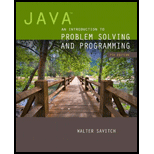
Explanation of Solution
Creating a class “RationalAssert.java”:
- Import required package.
- Define the class “RationalAssert”.
- Declare the private variables “the_numerator”, and “the_denominator”.
- Define parameterized constructor.
- Assign “numerator” to “the_numerator”.
- Assign “denominator” to “the_denominator”.
- Create an assertion with the condition “assert the_denominator != 0”.
- Give mutator methods to set numerator and denominator.
- Give accessor methods to get the value of numerator and denominator.
- Give function definition for “value ()”.
- Return the value produced by “the_numerator / the_denominator”.
- Given function “toString ()”.
- Return the string “the_numerator / the_denominator”.
- Define the “main ()” method.
- Create an object for “Scanner” class.
- Declare the variables “n”, and “d”.
- Get the numerator and denominator from the user.
- Call the constructor by passing “n”, and “d”.
- Call the function “value”.
- Call the function to get the numerator and denominator.
- Print new line.
Program:
Rational.java:
import java.util.Scanner;
//Define a class
public class RationalAssert
{
//Declare required variables
private int the_numerator;
private int the_denominator;
//Parameterized constructor
public RationalAssert(int numerator, int denominator)
{
//Assign the value of numerator
the_numerator = numerator;
//Assign the value of denominator
the_denominator = denominator;
//Declare an assertion
assert the_denominator != 0;
}
//Function to set the value of numerator
public void setNumerator(int numerator)
{
//Set the value
the_numerator = numerator;
}
//Function to set the denominator
public void setDenominator(int denominator)
{
//Declare an assertion
assert the_denominator != 0;
//Assign the value
the_denominator = denominator;
}
�...
Want to see the full answer?
Check out a sample textbook solution
Chapter 9 Solutions
Java: An Introduction to Problem Solving and Programming (7th Edition)
- Draw an ERD that represents a book in a library system. Be sure to add relationship types, key attributes, attributes and multiplicity on the ERD.arrow_forward2:21 m Ο 21% AlmaNet WE ARE HIRING Experienced Freshers Salesforce Platform Developer APPLY NOW SEND YOUR CV: Email: hr.almanet@gmail.com Contact: +91 6264643660 Visit: www.almanet.in Locations: India, USA, UK, Vietnam (Remote & Hybrid Options Available)arrow_forwardProvide a detailed explanation of the architecture on the diagramarrow_forward
- hello please explain the architecture in the diagram below. thanks youarrow_forwardComplete the JavaScript function addPixels () to calculate the sum of pixelAmount and the given element's cssProperty value, and return the new "px" value. Ex: If helloElem's width is 150px, then calling addPixels (hello Elem, "width", 50) should return 150px + 50px = "200px". SHOW EXPECTED HTML JavaScript 1 function addPixels (element, cssProperty, pixelAmount) { 2 3 /* Your solution goes here *1 4 } 5 6 const helloElem = document.querySelector("# helloMessage"); 7 const newVal = addPixels (helloElem, "width", 50); 8 helloElem.style.setProperty("width", newVal); [arrow_forwardSolve in MATLABarrow_forward
- Hello please look at the attached picture. I need an detailed explanation of the architecturearrow_forwardInformation Security Risk and Vulnerability Assessment 1- Which TCP/IP protocol is used to convert the IP address to the Mac address? Explain 2-What popular switch feature allows you to create communication boundaries between systems connected to the switch3- what types of vulnerability directly related to the programmer of the software?4- Who ensures the entity implements appropriate security controls to protect an asset? Please do not use AI and add refrencearrow_forwardFind the voltage V0 across the 4K resistor using the mesh method or nodal analysis. Note: I have already simulated it and the value it should give is -1.714Varrow_forward
 C++ Programming: From Problem Analysis to Program...Computer ScienceISBN:9781337102087Author:D. S. MalikPublisher:Cengage LearningProgramming Logic & Design ComprehensiveComputer ScienceISBN:9781337669405Author:FARRELLPublisher:Cengage
C++ Programming: From Problem Analysis to Program...Computer ScienceISBN:9781337102087Author:D. S. MalikPublisher:Cengage LearningProgramming Logic & Design ComprehensiveComputer ScienceISBN:9781337669405Author:FARRELLPublisher:Cengage EBK JAVA PROGRAMMINGComputer ScienceISBN:9781337671385Author:FARRELLPublisher:CENGAGE LEARNING - CONSIGNMENT
EBK JAVA PROGRAMMINGComputer ScienceISBN:9781337671385Author:FARRELLPublisher:CENGAGE LEARNING - CONSIGNMENT Microsoft Visual C#Computer ScienceISBN:9781337102100Author:Joyce, Farrell.Publisher:Cengage Learning,
Microsoft Visual C#Computer ScienceISBN:9781337102100Author:Joyce, Farrell.Publisher:Cengage Learning, C++ for Engineers and ScientistsComputer ScienceISBN:9781133187844Author:Bronson, Gary J.Publisher:Course Technology Ptr
C++ for Engineers and ScientistsComputer ScienceISBN:9781133187844Author:Bronson, Gary J.Publisher:Course Technology Ptr Programming with Microsoft Visual Basic 2017Computer ScienceISBN:9781337102124Author:Diane ZakPublisher:Cengage Learning
Programming with Microsoft Visual Basic 2017Computer ScienceISBN:9781337102124Author:Diane ZakPublisher:Cengage Learning





